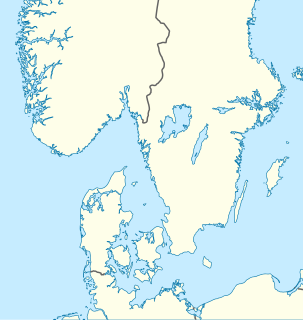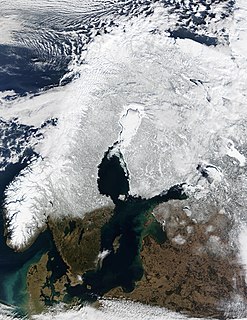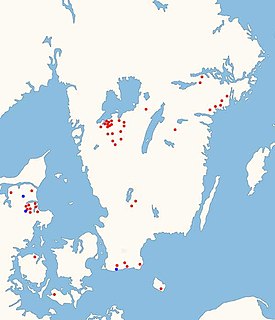
The Funbo runestones constitute a group of four runestones originally from Funbo in the province of Uppland, Sweden, which were raised by members of the same family during the eleventh century.

The Saleby Runestone, designated as Vg 67 in the Rundata catalog, was originally located in Saleby, Västra Götaland County, Sweden, which is in the historic province of Västergötland, and is one of the few runestones that is raised in memory of a woman.

The Norra Härene Runestone, designated as Vg 59 by Rundata, is a Viking Age memorial runestone that is located on the grounds of Dagsnäs Castle, which is about seven kilometers south of Skara, Västra Götaland County, Sweden, in the historic province of Västergötland.

The Velanda Runestone, designated as Vg 150 in the Rundata catalog, is a runestone that is dated from the late tenth century or the early eleventh century and which is located in the village of Velanda, Trollhättan Municipality, Västra Götaland County, Sweden, which is in the historic province of Västergötland.

The Viking runestones are runestones that mention Scandinavians who participated in Viking expeditions. This article treats the runestone that refer to people who took part in voyages abroad, in western Europe, and stones that mention men who were Viking warriors and/or died while travelling in the West. However, it is likely that all of them do not mention men who took part in pillaging. The inscriptions were all engraved in Old Norse with the Younger Futhark. The runestones are unevenly distributed in Scandinavia: Denmark has 250 runestones, Norway has 50 while Iceland has none. Sweden have as many as between 1,700 and 2,500 depending on definition. The Swedish district of Uppland has the highest concentration with as many as 1,196 inscriptions in stone, whereas Södermanland is second with 391

Runic inscription U 873 is the Rundata catalog number for a Viking Age memorial runestone that is located in Örsunda, which is about one kilometer west of Örsundsbro, Uppsala County, Sweden, which is in the historic province of Uppland.

This runic inscription, designated as U Fv1976;104 in the Rundata catalog, is on a Viking Age memorial runestone that is located at the Uppsala Cathedral, Uppland, Sweden.

The Björklinge runestones are five Viking Age memorial runestones designated in the Rundata catalog as U 1045, U 1046, U 1047, U 1048, and U 1050 that are located at the church in Björklinge, Uppsala County, Sweden, which is in the historic province of Uppland. In addition, there is a small fragment of a runestone with a partial runic text i * lit * rita * meaning "had erected" that has been given the catalog number U 1049.

Östergötland Runic Inscription 224 or Ög 224 is the Rundata catalog number for a Viking Age memorial runestone that is located in Stratomta, which is 9 kilometers east of Linköping, Östergötland, Sweden. The runestone has an inscription on two sides with an image of a ship on the south side.

Södermanland Runic Inscription 158 or Sö 158 is the Rundata catalog number for a Viking Age memorial runestone located in Österberga, which is one kilometer southwest of Ärsta and three kilometers southwest of Runtuna, Södermanland County, Sweden, and in the historic province of Södermanland. The inscription includes an image of a ship and uses same-stave bind runes to commemorate a man described as being a thegn.

Sö Fv1948;295 is the Rundata catalog number for a Viking Age memorial runestone that is located in Prästgården, which is just west of Jönåker, Södermanland County, Sweden. It commemorates two men who are described as being thegns.

The Bjäresjö Runestones are three Viking Age memorial runestones originally located adjacent to Bjäresjö Church in Bjäresjö, which is about 3 kilometers northwest of Ystad, Skåne County, Sweden. Two of the stones were discovered near the church, and two of the stones have been moved to other nearby locations. Although these three stones are located in Sweden, they have been given Danish designations because Scania was part of the historic Denmark.

The Fölene Runestones are two Viking Age memorial runestones which are located near the church in Fölene, which is about two kilometers west of Herrljunga, Västra Götaland County, Sweden, which was in the historic province of Västergötland. The stones are memorials to two men who were described as holding the title drengr.
The Bjärby Runestones are two Viking Age memorial runestones located near Grästorp, Sweden, in Bjärby synod, which was in the historic province of Västergötland. The two stones are memorials to men who held the titles thegn and drengr, and one has a depiction of the hammer of the Norse pagan deity Thor.

The Ballstorp Runestone, listed as Vg 62 in the Rundata catalog, is a Viking Age memorial runestone located on the grounds of the ruins of a church in Ballstorp, which is about 8 kilometers northwest of Floby, Västra Götaland County, Sweden, which is in the historic province of Västergötland.

The Västra Nöbbelöv Runestone, listed as DR 278 in the Rundata catalog, is a Viking Age memorial runestone located in Västra Nöbbelöv, which is about 3 kilometers east of Skivarp, Skåne County, Sweden, and was in the historic province of Scania.

The Källby Runestones are two Viking Age memorial runestones located in Källby, Västra Götaland County, Sweden, which was in the historic province of Västergötland.

Västergötland Runic Inscription 73 or Vg 73 is the Rundata catalog number for a Viking Age memorial runestone that is located near the Synnerby church, which is about nine kilometers west of Skara. The stone was raised in memory of a man who was a thegn.

The Asferg Runestone, listed as DR 121 in the Rundata catalog, is a Viking Age memorial runestone found at Asferg, which is about 10 km northeast of Randers, Aarhus County, Region Midtjylland, Denmark.

Västergötland Runic Inscription 90 or Vg 90 is the Rundata listing for a Viking Age memorial runestone located in Torestorp, which is about three kilometers northwest of Gudhem, Västra Götaland County, Sweden, and in the historic province of Västergötland.

























